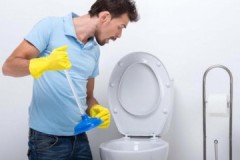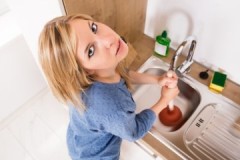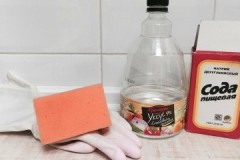Recipes and methods on how to clear a blockage in a sink at home on your own
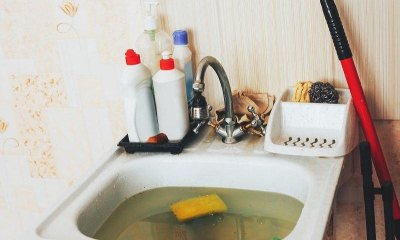 A blockage in the sink in the kitchen or bathroom is a situation that even a very neat housewife can face.
A blockage in the sink in the kitchen or bathroom is a situation that even a very neat housewife can face.
You can entrust the plumbing with cleaning the drain, but in most cases it is possible to solve the problem on your own.
Read about how and by what means you can unclog the blockage in the sink yourself in the article.
Content
Causes of occurrence
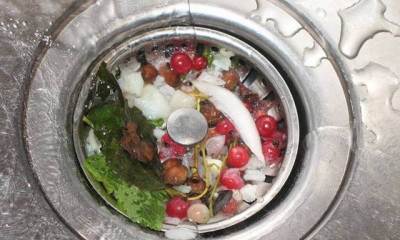 During operation, a blockage may form in the sink for several reasons:
During operation, a blockage may form in the sink for several reasons:
- Incorrect plumbing installation.
- Corrosion and accumulation of fatty deposits.
- Foreign objects entering the drain - debris, hair, food debris, etc.
If the communications under the sink were installed incorrectly, with violations, then blockages can become a constant problem. In this case, only reinstallation will help, and clearing the blockages by any of the methods will only give a temporary effect.
How to remove it mechanically?
In the event of serious blockages with complete or partial blocking of the wastewater outflow, mechanical treatment methods have shown themselves to be one of the most effective. In cases where the plug is formed by foreign objects, especially of non-organic origin, such methods are the best.
Ventuz
One of the simplest devices for cleaning a sink and a bath is a plunger. The principle of working with it is not complicated:
- in a sink with water, place the plunger vertically, holding the handle;
- press the handle, and sharply raise the plunger up and towards yourself;
- repeat.
With severe blockages, the plunger may be ineffective.
Glass
If there is no plunger available, and the blockage is not strong, then you can even get by with a glass. Order of use:
- Lower a glass into a sink with water so that the free edge covers the drain hole.
- With a sharp movement, raise the glass up and towards yourself.
- Repeat several times.
Cable
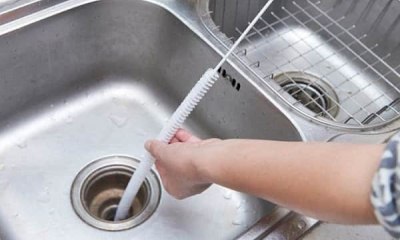 Special plumbing cable - cleaning device sewerage system mechanically.
Special plumbing cable - cleaning device sewerage system mechanically.
It is a cable, at one end of which there is a handle for rotation, at the other - a nozzle with a brush, which is designed for cleaning.
The principle of operation is to introduce a cable with a brush at the end into the sewer. Turning the handle, move the tool along the drain so as to clean the pipes. The cable allows you to clean the drain even with difficult blockages.
How to remove folk remedies?
Simple homemade recipes are based on readily available remedies.... It is not difficult to use them. The main disadvantage of such funds is weak effectiveness against complex blockages. Folk methods are suitable for preventing the formation of deposits in pipes during operation.
Boiling water
Hot water, or even better - boiling water, is a good way to clean drains, but only if the pipes are metal. This method is not suitable for plastic sewers, as it can lead to deformation and other damage to the drainage system. The use of boiling water is most effective against blockages in the kitchen.
Order of use:
- boil at least 1.5 liters. water;
- pour water into the drain in a thin stream;
- leave for 30-50 minutes;
- repeat the flushing procedure.
Vinegar with soda
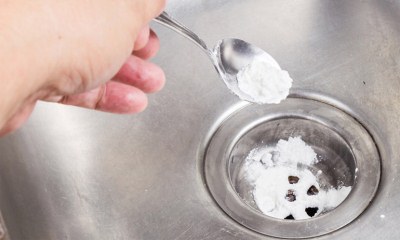 Scrubbing with baking soda and vinegar is an easy way to deal with unwanted blockages. Also, this option is suitable as a means of prevention.
Scrubbing with baking soda and vinegar is an easy way to deal with unwanted blockages. Also, this option is suitable as a means of prevention.
Application:
- Remove water from sink and drain.
- Pour 100-200 grams of soda into the drain.
- Pour in ½ cup vinegar.
- Plug the drain.
- After the reaction with the formation of foam (15-30 minutes), rinse the drain with boiling water.
Soda and salt
Suitable for removing fat deposits in the kitchen sink. Procedure:
- drain the drain;
- prepare a container for mixing ingredients;
- pour 200-250 grams of water;
- pour in ½ cup of soda;
- add 1 glass of salt;
- mix;
- pour the solution into the drain;
- an hour later, using a plunger, pierce the sink;
- drain the hot water into a drain.
How to remove with special chemistry?
Special household chemicals can be used to clear the blockage in the sinks. These products come in the form of powders or gels.
When choosing a specific drug, you must consider:
- price;
- expense of funds (for how many applications it is designed for);
- form of release;
- speed of impact;
- composition (for septic tanks, the choice of chemistry should be especially careful).
It is important to study the information on the procedure for use on the packaging with the tool
Tiret Turbo gel
The preparation in the form of a gel is aimed at eliminating blockages at home. The product contains chlorine, suitable for cleaning plastic and metal pipes.
Tiret is effective, it handles even difficult blockages in a short time, and it disinfects. Half a bottle is used for one treatment - the consumption is large. The cost is about 400 rubles.
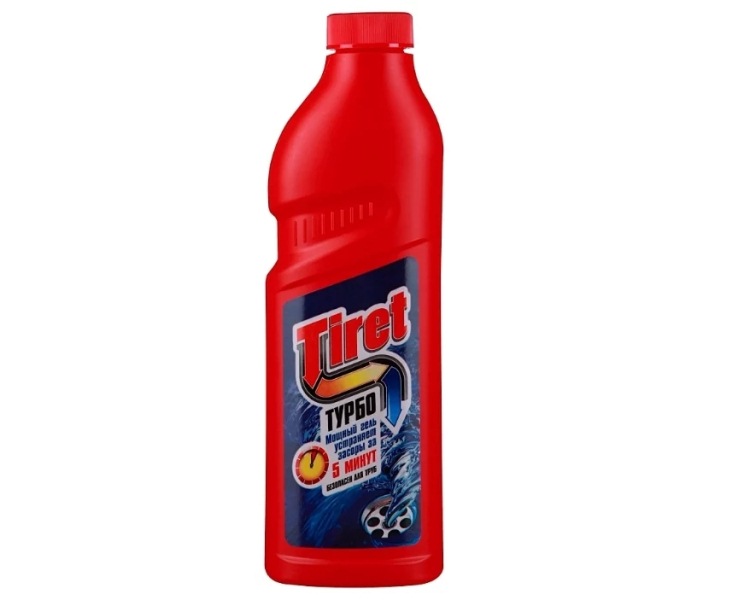
Bagi Pothan
Bugs is a granular blockage agent used in bathroom pipes, sinks, and toilet bowls. Contains sodium hydroxide. Suitable for plastic and metal pipes.
Pothan is suitable for removing blockages in kitchen and bathroom sinks. If the agent enters the drain begins to act effectively, dissolving:
- food residues,
- hair,
- diapers,
- paper,
- polyethylene.
Application:
- Remove excess water from the sink.
- Pour 70 to 100 grams of the drug into the drain.
- Pour in ½ cup hot water.
- Leave on for 3 minutes.
- Rinse with plenty of water.
- If necessary, the processing can be repeated.
The price for 0.6 kg is an average of 700 rubles. The packaging is sufficient for at least 10 applications.
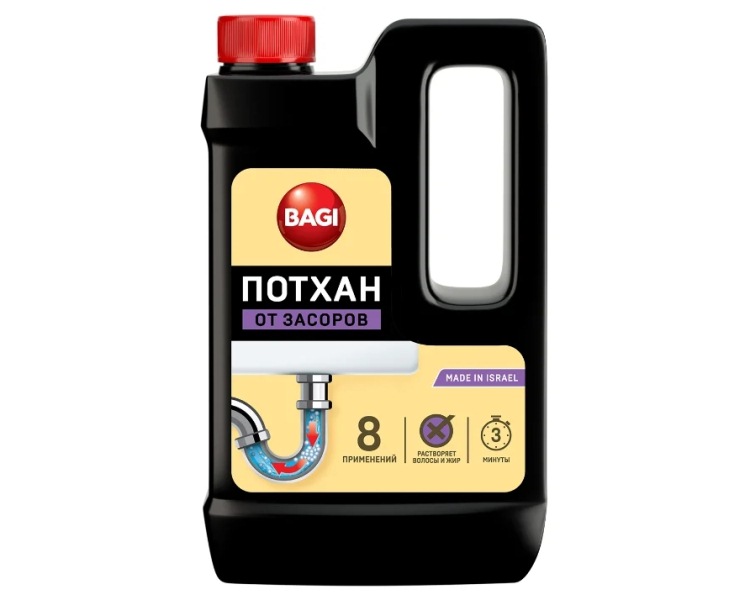
Expel
The product is designed to remove blockages from hair. The use of the drug is simple:
- Pour the contents of the package into the drain.
- Pour in a glass of warm water.
- After 30-50 minutes, rinse with plenty of water.
The product does not contain chlorine and is odorless.The tool can be used prophylactically once a month. Price - up to 135 rubles.
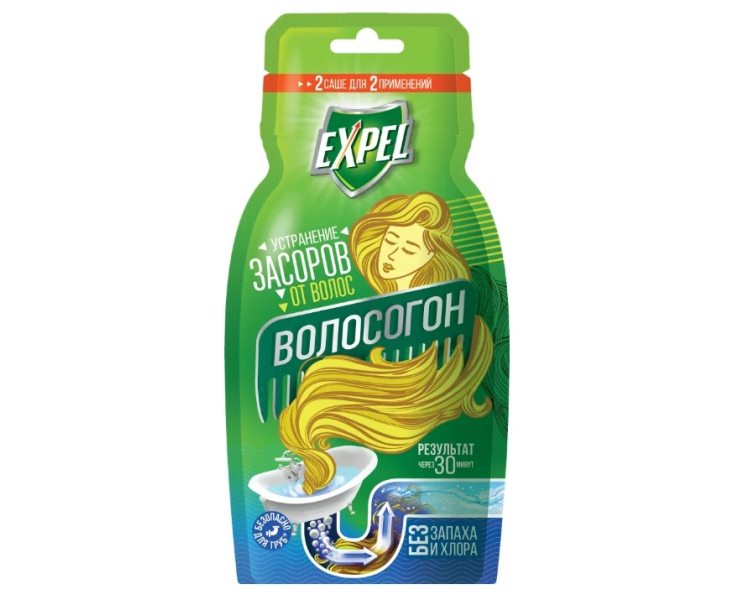
Parsing the siphon
Siphon under sinks - a collapsible device that can be cleanedby simply disconnecting it from the system. Despite the features of the models, the principle of organizing the devices is very similar. For the most part, cleaning is not difficult, and can be easily carried out on your own, without the involvement of a plumber.
No sophisticated tools or special skills are required for cleaning. Parts under the sink in plastic systems are fixed with plastic fasteners, which can be unscrewed simply by hand.
When untwisting the elements of the siphon, it is necessary to check the condition of the gaskets. If they wear out, replacement will be required.
Clearing the blockage in the kitchen sink is shown in stages in the video:
Feature of plastic pipe cleaning
Plastic pipes are the most common option for organizing sewerage... Most special anti-blockages are designed for pipes made of any material, including plastic.
When cleaning plastic communications according to folk recipes, it is necessary to use just hot water (up to 70 ° C) instead of boiling water. Otherwise the pipes may be damaged.
Mechanical cleaning should also take into account the exactingness of the material. Of chemical preparations, a good effect is given by means with the entry of potassium hydroxide and sodium.
Plumber call
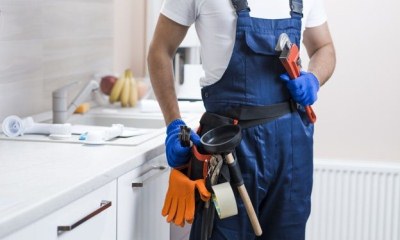 Seeking help from a specialist can be recommended in such cases:
Seeking help from a specialist can be recommended in such cases:
- there is no time and desire to mess around with cleaning the sewer;
- it was not possible to solve the problem on our own;
- the blockage affects the riser or its location could not be determined.
A plumber will help you deal with a blockage of any complexity. If at the same time it is required to replace worn-out parts and assemblies, the customer pays for them separately.
On average, the cost of eliminating household blockages in the capital is from 700 rubles. It is not difficult to find a company providing such services on the Internet in your city.
Preventive measures
Prevention measures are not complicated, but thanks to them, problems with water flow will occur much less often:
- It is advisable to install a special sieve into the sink drain holes (both in the kitchen and in the bathroom). It will help prevent coarse particles and hair from entering the drain.
- Boiling water should be regularly poured into the drain (for plastic pipes, just hot water). This will prevent sediments from accumulating on the surface of drainage communications.
- Do not clean food residues, mortars, water after washing shoes, etc. into the sink.
Cleaning prohibitions
When clearing a blockage in a sink it is recommended to take into account such prohibitions:
- you should not mix several agents at the same time, as as a result, very caustic vapors can be released, and a mixture of aggressive substances can even damage pipes;
- do not use household chemicals with bare hands;
- When unclogging the blockage, remove all foreign objects away from the sink that could get accidental splashes of chemicals - dishes, toothbrushes, towels, etc.
6 recommendations
Plumbers are advised to adhere to the following recommendations:
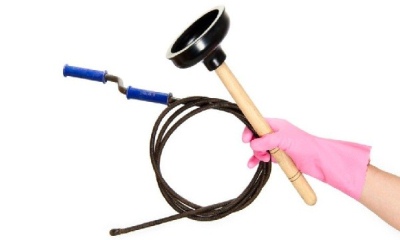 All work to remove blockages in the sink must be carried out with gloves.
All work to remove blockages in the sink must be carried out with gloves.- It is advisable to use household chemicals if you have a respirator and if you have good ventilation.
- After use, the plumbing cable must be cleaned and dried, and only then sent to storage. Otherwise, it will rust.
- It is better to use home remedies for cleaning plugs in pipes at the initial stage of blockage or as a preventive measure. Boiling water or soda is unlikely to cope with a serious problem.
- In case of global blockages, when water does not pass through the riser at home, only a professional plumber can help.
- Ignoring blockage prevention measures contributes to their frequent repetition.
Conclusion
In most cases, you can clean the blockage in the sink at home on your own, using chemical and mechanical methods. In difficult cases or in the absence of the possibility of cleaning yourself, you can turn to the services of professionals who will cope with any problem.

